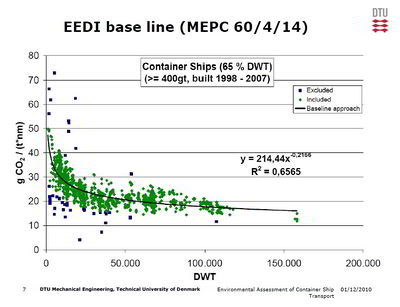Difference between revisions of "Exhaust Emission Module"
| Line 15: | Line 15: | ||
EEID is a measure of the CO2 efficiency of a ship. The basic principle of EEDI is that it expresses the CO2 emissions per unit of the transport work of the ship. | EEID is a measure of the CO2 efficiency of a ship. The basic principle of EEDI is that it expresses the CO2 emissions per unit of the transport work of the ship. | ||
A PPT presentation on EEDI can be found here: [[ | A PPT presentation on EEDI can be found here: [[file:101129_skibsfart_hohk.pdf]]. | ||
== System for Calculating Exhaust Emissions in Finland == | == System for Calculating Exhaust Emissions in Finland == | ||
Revision as of 09:08, 1 September 2012
Introduction
At its 29th meeting, the IWRAP Steering Group decided that it would be useful if IWRAP could be be used for estimating the CO2 and other emissions from vessel movements within a given IWRAP model. Gatehouse agreed to develop a first version of such a plug-in module for IWRAP.
The purpose of this page is to collect resources and references useful for this development.
Energy Efficiency Design Index (EEDI)
Mr. Hans Otto Kristensen from the Danish Technical University (DTU) has done a lot of work on The Energy Efficiency Design Index (EEDI).
The first version of the IWRAP Emission module wil lbe based on the work of Mr. Hans Otte Kristensen.
EEID is a measure of the CO2 efficiency of a ship. The basic principle of EEDI is that it expresses the CO2 emissions per unit of the transport work of the ship.
A PPT presentation on EEDI can be found here: File:101129 skibsfart hohk.pdf.
System for Calculating Exhaust Emissions in Finland
Markus Porthin from VTT in Finland provided this information to the IWRAP SG: LIPASTO - a calculation system for traffic exhaust emissions and energy consumption in Finland. The system is developed by VTT Technical Research Centre of Finland.
Exhaust Emissions in Ice Conditions
Also from Markus Porthin: Calculation of CO, NOx, SOx, CO2, Particles, Fuel consumption as emissions per second (database from FMI), based on:
- Speed
- Ice thickness
- Ship type
- Assisted or not assisted
Section 5.2 of Innovative Icebreaking Concepts for Winter Navigation dealing with Gas Emissions.
